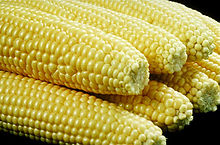
Back ذرة شامية حلوة Arabic ذره حلوه ARZ Blat de moro dolç Catalan Zuckermais German Sukermaizo Esperanto Maíz dulce Spanish Arto gozo Basque ذرت شیرین Persian Sokerimaissi Finnish Maïs doux French
| Sweet corn | |
|---|---|
 Husked sweet corn | |
| Species | Zea mays convar. saccharata var. rugosa |
| Origin | United States |

Sweet corn (Zea mays convar. saccharata var. rugosa),[1] also called sweetcorn, sugar corn and pole corn, is a variety of maize grown for human consumption with a high sugar content. Sweet corn is the result of a naturally occurring recessive mutation in the genes which control conversion of sugar to starch inside the endosperm of the corn kernel. Sweet corn is picked when still immature (the milk stage) and prepared and eaten as a vegetable, unlike field corn, which is harvested when the kernels are dry and mature (dent stage).[2] Since the process of maturation involves converting sugar to starch, sweet corn stores poorly and must be eaten fresh, canned, or frozen, before the kernels become tough and starchy.
It is one of the six major types of corn, the others being dent corn, flint corn, pod corn, popcorn, and flour corn.[3]
According to the USDA, 100 grams of raw yellow sweet corn contains 3.43 g glucose, 1.94 g fructose, and 0.89 g sucrose.[4]
| Nutritional value per 100 g (3.5 oz) | |||||||||||||||||||||||||||||
|---|---|---|---|---|---|---|---|---|---|---|---|---|---|---|---|---|---|---|---|---|---|---|---|---|---|---|---|---|---|
| Energy | 360 kJ (86 kcal) | ||||||||||||||||||||||||||||
19.02 g | |||||||||||||||||||||||||||||
| Sugars | 3.22 g | ||||||||||||||||||||||||||||
| Dietary fiber | 2.7 g | ||||||||||||||||||||||||||||
1.18 g | |||||||||||||||||||||||||||||
3.2 g | |||||||||||||||||||||||||||||
| Tryptophan | 0.023 g | ||||||||||||||||||||||||||||
| Threonine | 0.129 g | ||||||||||||||||||||||||||||
| Isoleucine | 0.129 g | ||||||||||||||||||||||||||||
| Leucine | 0.348 g | ||||||||||||||||||||||||||||
| Lysine | 0.137 g | ||||||||||||||||||||||||||||
| Methionine | 0.067 g | ||||||||||||||||||||||||||||
| Cystine | 0.026 g | ||||||||||||||||||||||||||||
| Phenylalanine | 0.150 g | ||||||||||||||||||||||||||||
| Tyrosine | 0.123 g | ||||||||||||||||||||||||||||
| Valine | 0.185 g | ||||||||||||||||||||||||||||
| Arginine | 0.131 g | ||||||||||||||||||||||||||||
| Histidine | 0.089 g | ||||||||||||||||||||||||||||
| Alanine | 0.295 g | ||||||||||||||||||||||||||||
| Aspartic acid | 0.244 g | ||||||||||||||||||||||||||||
| Glutamic acid | 0.636 g | ||||||||||||||||||||||||||||
| Glycine | 0.127 g | ||||||||||||||||||||||||||||
| Proline | 0.292 g | ||||||||||||||||||||||||||||
| Serine | 0.153 g | ||||||||||||||||||||||||||||
| |||||||||||||||||||||||||||||
| Other constituents | Quantity | ||||||||||||||||||||||||||||
| Water | 75.96 g | ||||||||||||||||||||||||||||
One ear of medium size (6-¾ to 7-½ inches long) maize has 90 grams of seeds | |||||||||||||||||||||||||||||
| †Percentages estimated using US recommendations for adults,[5] except for potassium, which is estimated based on expert recommendation from the National Academies.[6] | |||||||||||||||||||||||||||||
- ^ Erwin, A. T. (July 1951). "Sweet Corn—Mutant or historic species?". Economic Botany. 5 (3). Springer New York: 302. Bibcode:1951EcBot...5..302E. doi:10.1007/bf02985153. S2CID 28127396.
- ^ "Corn".
- ^ Linda Campbell Franklin, "Corn," in Andrew F. Smith (ed.), The Oxford Encyclopedia of Food and Drink in America. 2nd ed. Oxford: Oxford University Press, 2013 (pp. 551–558), p. 553.
- ^ FoodData Central (USDA). Search for "corn, sweet, yellow, raw" and click on "SR Legacy Foods".
- ^ United States Food and Drug Administration (2024). "Daily Value on the Nutrition and Supplement Facts Labels". FDA. Archived from the original on 2024-03-27. Retrieved 2024-03-28.
- ^ National Academies of Sciences, Engineering, and Medicine; Health and Medicine Division; Food and Nutrition Board; Committee to Review the Dietary Reference Intakes for Sodium and Potassium (2019). "Chapter 4: Potassium: Dietary Reference Intakes for Adequacy". In Oria, Maria; Harrison, Meghan; Stallings, Virginia A. (eds.). Dietary Reference Intakes for Sodium and Potassium. The National Academies Collection: Reports funded by National Institutes of Health. Washington, DC: National Academies Press (US). pp. 120–121. doi:10.17226/25353. ISBN 978-0-309-48834-1. PMID 30844154. Retrieved 2024-12-05.